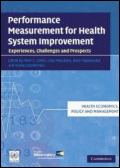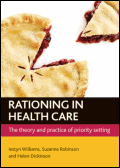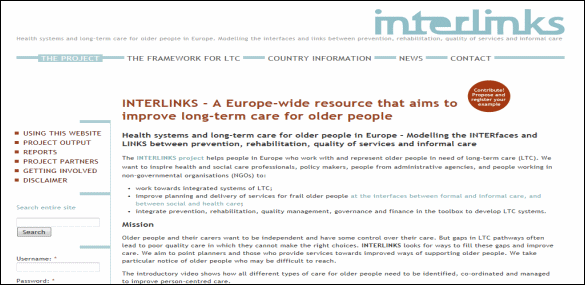LU POUR VOUS DE DECEMBRE 2011 :
 livres du mois
livres du mois
 sites du mois
sites du mois
 working papers
working papers
Tous les lu pour vous
LES LIVRES DU MOIS
Manifeste pour une santé égalitaire et solidaire.
Grimaldi A., Tabuteau D., Bourdillon F., Pierru F., Lyon-Caen A.
Paris : Odile Jacob : 2011 : 189 p.
Notre système de santé solidaire est à la croisée des chemins car il doit affronter plusieurs crises : économique, sanitaires, professionnelles... Les périls les plus lourds viennent des choix « libéraux » opérés depuis le début des années 2000. Le service public hospitalier est remis en cause. Le financement des soins courants connaît une privatisation rampante. En médecine de ville, la pratique des dépassements d'honoraires se banalise tandis que, sur le territoire, les déserts médicaux se multiplient. Cette politique qui sape un peu plus chaque jour les principes fondateurs de la Sécurité sociale n'est pas une fatalité. Une autre politique est possible, pour conforter et développer les services publics de la santé. Six principes doivent la guider : la solidarité, l'égalité, la prévention, la qualité des soins, l'éthique médicale, la démocratie sanitaire. Sur la base de ces principes, des propositions concrètes sont avancées dans ce manifeste. L'objectif est simple : faire de la santé un enjeu du débat public lors des prochaines échéances électorales. La solidarité est une politique d'avenir ; il n'y a pas d'avenir sans une politique de solidarité (4e de couverture).
Sécu : objectif monde. Le défi universel de la protection sociale.
Hirsch M., Morin C.
Paris : Stock : 2011 : 158 p.
Cet ouvrage plaide pour l'établissement d'un socle universel de protection sociale. Il s'appuie sur sur les travaux d'une commission internationale (Commission Bachelet) pour tracer la voie d'une protection sociale mondiale, sur des expériences et programmes qui commencent à porter ses fruits.0
Economie politique de la protection sociale.
Elbaum M.
Paris : Presses Universitaires de France : 2011 : 443 p.
Ce manuel analyse les principaux problèmes économiques auxquels est confrontée la protection sociale en France : démographie-vieillissement, emploi, redistribution, financement, régulation, évaluation. Rassemblant des éléments de connaissance souvent dispersés, il fournit sur chacun de ces points une synthèse mobilisant les enseignements de l'analyse économique, les comparaisons européennes et, pour la France, l'ensemble des données récentes. Destiné aux étudiants des deuxièmes cycles universitaires ou préparant des concours administratifs, il s'adresse aussi à un public plus large. Donnant de l'intelligibilité aux débats et aux réformes intervenus dans notre pays depuis vingt ans, il présente avec clarté les contraintes qui pèsent sur notre système de protection sociale, mais aussi les choix collectifs dont dépendront à l'avenir nos objectifs de cohésion sociale (4e de couverture).
Maisons de santé, une urgence citoyenne.
Depinoy D.
Paris : Editions de santé : 2011 : 116 p.
Le système de santé est en plein changement et les défis liés aux évolutions démographiques, comportementales, épidémiologiques et des pratiques médicales imposent une nouvelle organisation. La structuration du premier niveau des soins – appelé le premier recours – peut apporter des résultats concrets rapides en matière de réduction des inégalités, d'amélioration de la qualité du service rendu et d'efficience. S'attacher de manière volontariste à soutenir l'émergence des modes d'exercice pluriprofessionnels et regroupés peut permettre de relever les enjeux majeurs de notre système de santé. Au-delà d'un effet de mode qui pousse à vouloir construire rapidement des maisons de santé, il y a matière à soutenir également d'autres formes de regroupement pluriprofessionnel pour constituer le socle d'une nouvelle médecine de premier recours. Il est nécessaire d'accompagner le changement pour donner une chance à ces nouvelles formes d'exercice en équipe mais aussi et surtout de faire preuve d'audace pour mener ces expériences à l'échelon national. Cet ouvrage détaille les enjeux de l'organisation du premier recours et propose des leviers de réussite des projets. Il s'adresse à tous les professionnels de santé qui désirent se lancer dans un projet de maison ou pôle de santé mais aussi aux élus et aux institutionnels qui ont besoin de clefs pour participer (4e de couverture).
L'éthique du care.
Brugere F.Paris : Presses Universitaires de France : 2011 : 127 p.
Le care est un concept jeune, mis au point dans les années 1980 aux États-Unis. Il est d'abord une éthique : à visage humain, contextuelle et renouvelée dans l'approche de la raison et des sentiments, une attention aux autres, des formes de responsabilisation. Le fondement théorique est une anthropologie de la vulnérabilité, la possibilité de rendre audible une voix des femmes et des fragiles. Cette éthique est enracinée dans des débats issus de la psychologie morale, puis une philosophie pratique, une sociologie et une politique. Aujourd'hui, le passage de l'éthique à la politique se fait grâce à la revendication du care comme philosophie sociale. C'est pour faire face à un cycle politique de dérégulations et à la crise de nos États providence que les philosophies du care appréhendent par les vies ordinaires liées au soin, ces armées de populations rendues invisibles et marginalisées dans la structure actuelle du marché. Le care, ou comment comprendre l'interdépendance et les dépendances aujourd'hui.
Dynamiques sanitaires des villes françaises.
Rican S., Salem G., Vaillant Z., Jougla E.
Paris : La documentation française ; Paris : Datar : 2010 : 76 p.
D'importants changements ont marqué la géographie des villes françaises depuis les années cinquante. Dans le même temps, l'état de santé de la population et la distribution des inégalités sanitaires se sont profondément transformés. L'objectif de cette étude est de constituer un état des lieux de ces dynamiques et de leurs interrelations sur la longue durée (1970-2000). Les territoires suivants, fortement contrastés font l'objet des études plus spécifiques : le Bassin parisien, le pourtour méditerranéen, le grand Nord-Est et le bassin rennais. En repérant les changements sanitaires urbains en cours, et en soulignant les tendances à l'oeuvre, cette approche permet d'éclairer le choix des décideurs. Cette étude s'adresse plus particulièrement à des chercheurs et des experts en géographie, en aménagement du territoire ou en santé publique ainsi qu'aux décideurs et acteurs publics, soucieux de bénéficier d'un éclairage nouveau sur les modes de constructions socio-territoriales de la société française (4e de couverture).
Performance measurement for health system improvement : experiences, challenges and prospects.
Mesure des performances pour l'amélioration des systèmes de santé : expériences, défis et perspectives.
Smith P.C., Mossialos E., Papanicolas I., Leatherman S.
Cambridge ; Cambridge University Press : 2009 : 22p. + 726 p.
In a world where there is increasing demand for the performance of health providers to be measured, there is a need for a more strategic vision of the role that performance measurement can play in securing health system improvement. This volume meets this need by presenting the opportunities and challenges associated with performance measurement in a framework that is clear and easy to understand. It examines the various levels at which health system performance is undertaken, the technical instruments and tools available, and the implications using these may have for those charged with the governance of the health system. Technical material is presented in an accessible way and is illustrated with examples from all over the world. Performance Measurement for Health System Improvement is an authoritative and practical guide for policy makers, regulators, patient groups and researchers.
Rationing in health care : the theory and practice of priority setting.
Williams I., Robinson S., Dickinson H.
Bristol : The Policy Press : 2011 : 7p.+159 p.
The challenges faced by those rationing scarce health care resources have intensified following the economic downturn. This book tackles this challenge by exploring the latest thinking and practice on priority setting methods. In an accessible style the book brings together theories, practice and evidence from a wide range of disciplines and provides practical, evidence-based prescriptions for decision makers. It will be of interest to all health care managers and students of health care policy and management (4e de couverture).
LES SITES DU MOIS DE DECEMBRE
ANCIEN (Assessing Needs of Care in European Nations)
www.ancien-longtermcare.eu/home
Presentation
Fruit d'un travail réalisé en réponse d'un appel d'offre européen, l'objectif de ce projet initié en 2009 est établir un état des lieux des systèmes de soins de long terme dans les pays membres de l'union européenne, d'évaluer le nombre actuel et futur de personnes âgées dépendantes dans quelques pays ; d'estimer les besoins et l'offre de soins de long terme, en faisant apparaître le rôle potentiel du progrès technique et des politiques de promotion de la qualité, d'identifier des indicateurs de performance afin de proposer une évaluation des différents systèmes de soins de long terme. Son site met en ligne les rapports nationaux issus des travaux des équipes impliqués.
ENEPRI (European Network of Economic Policy Research Institutes)
www.enepri.org
Presentation
Ce réseau fédère des instituts de recherche en politique économique de la plupart des pays de l'Union européenne. Les objectifs du réseau sont de favoriser la diffusion internationale de la recherche existante, de coordonner les plans de recherche, d'effectuer des recherches conjointes et sensibiliser le public à la dimension européenne des questions de politique économique. Les activités d'ENEPRI comprennent l'organisation d'ateliers et de conférences, la publication de documents de travail et de rapports (en ligne sur le site) et le développement de projets de recherche communs. Ces activités sont coordonnées et gérées par le CEPS (Centre for European Policy Studies)
Interlinks
interlinks.euro.centre.org
Presentation
Fruit d'un travail réalisé en réponse d'un appel d'offre européen. L'objectif principal de ce projet est de construire et de valider un modèle permettant de décrire, d'analyser et de comparer les systèmes de soins de longue durée (SLD) des pays européens en ciblant les personnes âgées. Ce projet comparatif vise à élaborer des concepts, des indicateurs et des modèles en matière de politiques et de pratiques de SLD en centrant son approche sur la problématique des déficits et des liens existant entre champs de la santé, du social et des SLD. Le site propose une documentation sur les principaux aspects des soins de longue durée (offre de soins, politique de prévention et de réadaptation, qualité du management et financement) pour chaque pays impliqué dans le projet.
VU DE L'ETRANGER : QUELQUES WORKING PAPERS ANALYSES
Assurance maladie
The Impact of the Macroeconomy on Health Insurance Coverage: Evidence from the Great Recession. 

L'impact de la macroéconomie sur la couverture d'assurance maladie: évidence issue de la grande récession.
Cawley J., Moriya A.S., Simon K.I.
Cambridge : NBER : 2011/11 : 37 p.
This paper investigates the impact of the macroeconomy on the health insurance coverage of Americans. We examine panel data from the Survey of Income and Program Participation (SIPP) for 2004-2010, a period that includes the Great Recession of 2007-09. We find that a one percentage point increase in the state unemployment rate is associated with a 1.67 percentage point (2.12%) reduction in the probability that men have health insurance; this effect is strongest among college-educated, white, and older (50-64 year old) men. For women and children, the unemployment rate was not significantly correlated with the probability of health insurance coverage through any source. When one examines the source of coverage, it becomes apparent that a one percentage point increase in the unemployment rate is associated with a 1.37 percentage point (4.69%) higher probability that a child is covered by public health insurance. Based on the point estimates in this paper, it estimates that 9.3 million adult Americans, the vast majority of whom were men, lost health insurance due to a higher unemployment rate alone during the 2007-09 recession. This is roughly nine times more than lost health insurance during the previous (2001) recession. It concludes with a discussion of how components of recent health care reform may influence these relationships in the future.
Economie de la santé
Is the European Welfare State really more expensive? 

L'Etat Providence européen est-il vraiment plus coûteux ?
Adema W., Fron P., Ladaique M.
Paris : OCDE : 2011 : 129 p.
This paper first presents information on trends and composition of social expenditure as in the OECD Social Expenditure database for the years 1980 – 2007 as well as estimates from 2008 – 2012.
Four decades of health economics through a bibliometric lens. 

Quatre décennies d'économie la santé à travers le prisme de la bibliométrie.
Wagstaff A., Culyer A.J.
York : University of York : 2011/10 : 21 p.
This paper takes a bibliometric tour of the past 40 years of health economics using bibliographic"metadata"from EconLit supplemented by citation data from Google Scholar and the authors'topical classifications. The authors report the growth of health economics (33,000 publications since 1969 -- 12,000 more than in the economics of education) and list the 300 most-cited publications broken down by topic. They report the changing topical and geographic focus of health economics (the topics'Determinants of health and ill-health'and'Health statistics and econometrics'both show an upward trend, and the field has expanded appreciably into the developing world). They also compare authors, countries, institutions, and journals in terms of the volume of publications and their influence as measured through various citation-based indices (Grossman, the US, Harvard and the JHE emerge close to or at the top on a variety of measures).
Etat de santé
A Panel Data Examination of the Determinants of Health Satisfaction. 

Un examen de données de panel sur les déterminants de la satisfaction en matière de santé.
Wilson M.S.
Rochester : Social Science Electronic Publishing : 2011 : 11 p.
This paper analyzes the determinants of an individual's health satisfaction. The unbalanced panel data are from the German socioeconomic Panel Survey, and consists of 7,293 participants and 7 time periods. Results found that older people become less satisfied with their health and people with more money tend to be more satisfied with their health ceteris paribus. In addition, becoming divorced does have a negative and somewhat economically significant effect on a person's health satisfaction. Conversely, being handicapped has little effect on a person's health satisfaction and people generally don't change their health satisfaction when they become handicapped.
Evidence on the Long Shadow of Poor Mental Health Across Three Generations. 

Evidence de la persistence des problèmes de santé mentale au travers de trois générations.
Johnston D.W, Schurer S., Shields M.A.
Bonn : IZA : 2011/10 : 39 p.
Individuals suffering from mental health problems are often severely limited in their social and economic functioning. Mental health problems can develop early in life, are frequently chronic in nature, and have an established hereditary component. The extent to which mental illness runs in families could therefore help explain the widely discussed intergenerational transmission of socioeconomic disadvantage. Using data from three generations contained in the 1970 British Cohort Study, we estimate the intergenerational correlation of mental health between mothers, their children, and their grandchildren. We find that the intergenerational correlation in mental health is about 0.2, and that the probability of feeling depressed is 63 percent higher for children whose mothers reported the same symptom 20 years earlier. Moreover, grandmother and grandchild mental health are strongly correlated, but this relationship appears to work fully through the mental health of the parent. Using grandmother mental health as an instrument for maternal mental health in a model of grandchild mental health confirms the strong intergenerational correlation. We also find that maternal and own mental health are strong predictors of adulthood socioeconomic outcomes. Even after controlling for parental socioeconomic status, own educational attainment, and own mental health (captured in childhood and adulthood), our results suggest that a one standard deviation reduction in maternal mental health reduces household income for their adult offspring by around 2 percent.
Hôpital
Using a Vector Autoregression Framework to measure the quality of English NHS hospitals. 

Utilisation d'un cadre d'autorégression vectorielle afin de mesurer la qualité des hôpitaux anglais appartenant au NHS.
Papanicolas I., McGuire A.
London : London School of Economics and Political Science : 2011/05 : 56 p.
In order to address the problem of poor quality information available to health care providers today, McClellan and Staiger (1999) developed a new method to measure quality, which addresses some key limitations of other approaches. Their method produces quality estimates that reflect different dimensions of quality and are able to eliminate systematic bias and noise inherent in these types of measures. While these measures are promising indicators, they have not been applied to other conditions or health systems since their publication. This paper attempts to replicated their 1999 method by calculating these quality measures for English Hospitals using Hospital Episode Statistics for the years 1996-2008 for Acute Myocardial Infarction (AMI) and Hip Replacement. Using the latent outcome measures calculated previously, Vector Autoregressions (VARs) are used to combine the information from different time periods and across measures within each condition. These measures are then used to compare current and past quality of care within and across NHS Acute Trusts. Our results support that this method is well suited to measure and predict provider quality of care in the English setting using the individual patient level data collected.
Using a latent variable approach to measure the quality of English NHS hospitals. 

Recours à une approche par variable latente pour mesurer la qualité des hôpitaux du NHS anglais.
Papanicolas I., McGuire A.
London : London School of Economics and Political Science : 2011/05 : 48 p.
The provision of performance information is essential for ensuring and improving the performance of health care systems. However, the lack of reliable quality information is a key problem in evaluating and improving health care. This paper estimates the performance of English NHS Acute Trusts using Dr. Foster data from the years 1996 – 2008 to investigate health outcomes after elective treatment for Acute Myocardial Infarction (AMI) and Hip Replacement. A latent variable approach is used to calculate the hospital quality effect in determining short and long term mortality and readmission rates for each year. These measures are then used to compare current and past quality of care within and across NHS Acute Trusts. The results support that this method is well suited to measuring provider quality of care. Using these quality measures we are able to investigate the performance of NHS Acute Trusts across this time period and identify hospitals where further scrutiny of low quality is required in the future.
Truly inefficient or providing better quality of care? Analysing the relationship between risk-adjusted hospital costs and patients' health outcomes. 

Les hôpitaux sont ils vraiment inefficaces ou fournissent-ils la meilleures qualité ? Analyse de la relation entre les coûts hospitaliers ajustés au risque et les résultats pour la santé des patients.
Gutacker N., Bojke C., Daidone S.
York : University of York : 2011/10 : 21 p.
Accounting for variation in the quality of care is a major challenge for the assessment of hospital cost performance. Because data on patients' health improvement are generally not available, existing studies have resorted to inherently incomplete outcome measures such as mortality or re-admission rates. This opens up the possibility that providers of high quality care are falsely deemed inefficient and vice versa. This study makes use of a novel dataset of routinely collected patient-reported outcomes measures (PROMs) to i) assess the degree to which cost variation is associated with variation in patients' health gain and ii) explore how far judgement about hospital cost performance changes when health outcomes are accounted for. We use multilevel modelling to address the clustering of patients in providers and isolate unexplained cost variation. Our results provide some evidence of a U-shaped relationship between risk-adjusted costs and outcomes for hip replacement surgery. For the other three investigated procedures, the estimated relationship is sensitive to the choice of PROM instrument. We do not observe substantial changes in estimates of cost performance when outcomes are explicitly accounted for.
Evaluating Hospital Efficiency Adjusting for Quality Indicators: an Application to Portuguese NHS Hospitals. 

Evaluation de l'efficience des hôpitaux ajustée aux indicateurs de qualité : une application aux hôpitaux publics portugais.
Almeida A., Fique J.P.
Porto : Universidade do Porto, Faculdade de Economia do Porto . 2011/10 ; 20 p.
The objective of this paper is to develop a methodology to incorporate measures of hospital quality in efficiency analysis, applied to Portuguese NHS hospitals, in order to assess whether there is a trade-off between efficiency and quality in Portuguese hospitals. We develop and compare two methodologies to compute DEA technical efficiency scores adjusted for output quality, for a sample of Portuguese NHS hospitals in 2009. When DEA efficiency scores are adjusted for output quality, the decision making units that lie on the technical efficiency frontier remain largely unaltered, even if a great weight is given to quality indicators over quantity indicators of output. Nevertheless, we find that outside of the frontier adjusting for quality does have an impact in efficiency scores.We conclude that the empirical evidence is not sufficient to identify a clear trade-off between efficiency and quality in the hospitals under review, implying the possibility that efficiency gains may achieved without a significant sacrifice of service quality. Nevertheless, there is enough evidence to conclude that analyzing hospital efficiency without consideration of differences in quality of service will generate biased results. When perceived quality is brought to the analysis, the gap between efficient and inefficient units tends to widen.
Inégalités devant soins
Persistence despite Action? Measuring the Patterns of Health Inequality in England (1997-2007). 

Persistance malgré l'action ? Mesurer les caractéristiques des inégalités de santé en Angleterre (1997-2007).
Hernandez-Quevedo C., Costa-Font J., McGuire A.
London : London School of Economics and Political Science : 2010/10 : 33 p.
The persistence of inequalities in health is a major policy concern in England, which was addressed by the new Labour government in 1997 through prioritising the curtailment of health inequalities as a policy goal. However, whether specific interventions have managed to attain their goals is a question for empirical welfare analysis to elucidate. This paper addresses two related questions: first, it empirically examines the dynamic patterns of inequalities in health in England from 1997 to 2007 by estimating concentration indexes of inequality over three measures of health, namely self-reported health, long standing illness and health limitations, calculated across different years of the Health Survey for England. Second, using regression-based decomposition analysis, we explore whether specifically prioritised areas (so-called “spearhead” local authority areas ranked in the bottom fifth on national health indicators) exhibit a different pattern of inequality in the years following a targeted intervention in 2005. Results suggest that patterns of health inequalities in England exhibit moderate variation from 1997 to 2007, although some improvement in self-assessed health inequalities is found. Importantly, patterns of inequality in prioritised (spearhead) areas are not found to be significantly different than health inequalities in non-spearhead areas.
Médicaments
The Effect of FDA Advisories on Branded Pharmaceutical Firms Valuations and Promotion Efforts. 

L'effet des avis de la FDA sur les évaluations et les efforts de promotion des entreprises pharmaceutiques.
Conti R.M., Huskamp H.A., Berndt E.R.
Cambridge : NBER : 2011/10 : 25 p.
The US Food and Drug Administration (FDA) expends considerable efforts in regulating medications approved for use. Yet the impact of medication labeling changes on brand pharmaceutical products, and whether and what firms do to respond to increased information regarding the safety and efficacy of a drug, have not be characterized. We propose a behavioral framework for examining the effects of FDA advisories on branded pharmaceutical firms and their products. We empirically assess the impact of recent FDA advisories on the stock market valuations of a sample of branded pharmaceutical manufacturing firms using event study methods. We examine whether and how branded pharmaceutical manufacturers respond to an advisory by assessing changes in promotion compared to non-affected firms. We find firms targeted by an advisory have average stock price declines of 3% in three days and 11% in five days following the advisory release, and in turn appear to decrease total physician-directed promotion spending, journals ads and detailing visits significantly six months following the advisory release; the provision of free samples is unaffected. We find no changes among therapeutic substitutes unaffected by the advisory. Results of sensitivity analyses suggest firms with market dominant positions experience similar decreases in stock market valuations and physician-directed promotion compared to pooled results. The results are also robust to alternative definitions of the timing of advisory release dates and the severity of advisories' wording. Theory and empirical results suggest the public release of FDA advisories negatively impacts firm's short-term market valuations. The results suggest an additional rationale for previously documented declines in prescribing after FDA advisory releases – significant declines in physician-directed promotion following FDA advisory releases; the combined (and likely correlated) effects of the release of the advisory and declines in physician-directed promotion on prescribing behavior are likely larger than the sum of the independent effects.
Operationalising Value Based Pricing of Medicines: A Taxonomy of Approaches. 

Mise en oeuvre des prix des médicaments basés sur la valeur : une taxonomie des approches.
Sussex J., Towse A., Devlin N.
York : CHE: 2011/08 : 29 p.
The purpose of this paper is to provide an account of the full set of possible means by which value based pricing (VBP) might be operationalised; to describe and categorise them by developing a taxonomy of approaches; to give an initial assessment of the challenges, pros and cons that each of the principal types of approach implies. To achieve this, we review the elements of value that could be taken into account, how they might be measured and valued, how the different elements could be combined into an overall assessment of a medicine's value, and how that then could be linked to the maximum price the health service is willing to reimburse. The UK Department of Health's consultation document regarding the introduction of VBP (DH, 2010a) outlines one possible approach to these steps – but others are possible. We begin with a brief discussion of value in economics and theoretical frameworks from economics relevant to the normative question of which attributes of medicines should be taken into account in VBP. We proceed to outline a taxonomy of approaches to VBP, taking as our starting point that VBP will include a measure of health gain and that this will be built on the QALY. Our principal interest is in the way criteria other than QALYs are taken into account. We set out to: (i) identify and describe the full range of alternative means by which “value” might be measured and valued, (ii) identify and describe the options available for aggregating the different components of value to establish a maximum price, and (iii) note the challenges and relative advantages associated with these approaches. Finally, we review the means by which VBP is currently operationalised in a selection of countries and place these, and proposals for the UK, in the context of our taxonomy.
Soins de santé primaires
Electronic Medical Records and Physician Productivity: Evidence from Panel Data Analysis. 

Les dossiers médicaux informatisés et la productivité des médecins : Evidence issue de l'analyse de données de panel.
Hemant K., Bhargava H.K., Mishra A.
Rochester : Social Science Electronic Publishing : 2011/11 : 39 p.
Physician productivity is an important driver of key healthcare outcomes, such as quality of care, treatment costs and patient satisfaction, because physicians influence a vast majority of treatment decisions, and are central to the care delivery process. Thus, it is critical for researchers to understand how transformation technologies, such as electronic medical records (EMRs) impact physician productivity. While researchers and policy makers in the United States have suggested that the implementation of EMRs can have significant beneficial impacts on patient safety, health care quality and overall costs of care delivery, the effects of EMRs on physicians themselves have been understudied in the literature. This paper examineS the productivity impacts of EMR implementation on physicians. Its focus is to investigate if productivity impacts of EMR implementation depend on physician specialties and the duration for which the EMR has been implemented. This research is informed by extant work in physician productivity, IT productivity and task-technology fit theory. It uses a unique panel dataset comprising 87 physicians specializing in internal medicine, pediatrics and family practice in 12 primary care clinics of an academic hospital in a large state in the western United States. Its dataset contains 3,186 physician-month productivity observations collected over 39 months. It employs random effects model on this panel dataset to estimate the impact of EMR implementation on physician productivity. It finds that productivity impacts of EMR are contingent upon physician specialty and the time period for which an EMR has been implemented. Furthermore, we find that the stable stage impacts of EMR on various specialties are different from those in the transitory learning stage. These results emphasize the need for fine-grained analyses of productivity impacts of EMR implementation on physicians. It postulates that the fit provided by an EMR to the task requirements of physicians of various specialties is key to disentangling the productivity dynamics. It contributes to the nascent but emerging stream of literature that examines productivity implications of various information technologies among white color knowledge workers in the service industries.
Organizational Economics and Physician Practices. 

L'économie organisationnelle et les pratiques des médecins.
Rebitzer J.B., Votruba M.E.
Cambridge : NBER : 2011/10 : 29 p.
Economists seeking to improve the efficiency of health care delivery frequently emphasize two issues: the fragmented structure of physician practices and poorly designed physician incentives. This paper analyzes these issues from the perspective of organizational economics. We begin with a brief overview of the structure of physician practices and observe that the long anticipated triumph of integrated care delivery has largely gone unrealized. We then analyze the special problems that fragmentation poses for the design of physician incentives. Organizational economics suggests some promising incentive strategies for this setting, but implementing these strategies is complicated by norms of autonomy in the medical profession and by other factors that inhibit effective integration between hospitals and physicians. Compounding these problems are patterns of medical specialization that complicate coordination among physicians. We conclude by considering the policy implications of our analysis - paying particular attention to proposed Accountable Care Organizations.
Systèmes de santé étrangers
Waiting Times and Cost Sharing for a Public Health Care Service with a Private Alternative: A Multi-Agent Approach. 

Temps d'attente et partage des coûts dans un service public de santé en présence d'un secteur privé : une approche multi-agent.
Rebba V., Rizzi D.
Rochester : Social Science Electronic Publishing : 2011 : 39 p.
Cost sharing represent a well-established tool for the control of health care demand in many Oecd countries, even though it is used with caution, and in combination with other instruments, in order to avoid potential negative impacts on access to essential health care services. Waiting lists and waiting times represent an alternative (and implicit) way to control demand in public health care systems, even though rationing by waiting may be an inferior solution to cost-sharing in terms of welfare. This paper focuses on the use of waiting times, cost-sharing, and other tools (in particular, priority and appropriateness criteria) in order to control demand for a public outpatient health service in presence of a fully paid out-of-pocket private alternative. We develop an agent-based model where heterogeneous agents maximise their individual utility based on income and health status. On this basis, we develop some computational.
Priority Setting in Health Care: Disentangling Risk Aversion from Inequality Aversion. 

L'établissement des priorités dans les soins de santé : démêler l'aversion au rique de l'aversion à l'inégalité.
Echazu L., Nocetti D.
Rochester : Social Science Electronic Publishing : 2011 : 23 p.
This paper introduces a tractable social welfare function that is rich enough to disentangle preferences towards risk in health outcomes from preferences towards health inequalities across individuals. Given this preference specification it evaluates how uncertainty over the severity of illness and over the effectiveness of treatments affects the optimal allocation of health care resources. It shows that the way in which uncertainty affects the optimal allocation within its proposed specification may differ sharply from that in the standard utilitarian framework. It also derives explicit solutions for the optimal allocation under risk for the case of a “Rawlsian” society.
Discrimination in a universal health system: Explaining socioeconomic waiting time gaps. 

Discrimination dans le système de santé universel : Expliquer les écarts socio-économiques du temps d'attente.
Johar M., Jones G., Keane M. et al.
Sydney : UTS ; 2011/10 ; 49 p.
One of the core goals of a universal health care system is to eliminate discrimination on the basis of socioeconomic status. This working paper tests for discrimination using patient waiting times for non-emergency treatment in public hospitals. Waiting time should reflect patients clinical need with priority given to more urgent cases. Using data from Australia, it finds evidence of prioritisation of the richest patients, especially the least urgent, who can be delayed with lower health risks, thereby allowing more scope for discrimination. The rich also benefit from variation in supply endowments. These results challenge the universal system's core principle of equitable treatment.
Travail et santé
The Effects of First Occupation on Long Term Health Status: Evidence from the Wisconsin Longitudinal Study. 

Les effets du premier emploi sur l'état de santé à long terme : évidence issue de l'étude longitudinale du Wisconsin.
Fletcher J.M.
Rochester : Social Science Electronic Publishing : 2011 : 35 p.
This paper uses a longitudinal survey that has collected information for 50 years on a large cohort of Wisconsin high school graduates and their siblings to examine the long term impact of early occupational choice on health status. It finds evidence that beginning a career in a blue collar occupation is correlated with several measures of poor health outcomes at ages 50-65. Since the dataset includes usually unobserved pre-labor market characteristics, including IQ and childhood health status, it shows that controlling for these variables is important for many results and suggests a high level of selection into occupation based on health and ability. It also provides evidence of gender differentials in the association between first occupation and later health. Then, it replaces its basic measure of occupational categories with summary measures of job characteristics and find that employment at “bad jobs” at the beginning of an individual's career predicts later health outcomes. Finally, it uses sibling information in the dataset to show that unmeasured family background factors explain a large share of the effects of occupation on later health. Overall, the evidence points to limited, though heterogeneous, long term effects of health from blue collar employment.
Work-Related Health in Europe: Are Older Workers More at Risk? 

Santé et travail en Europe : les travailleurs âgés sont ils plus exposés au risque ?
Jones M.K, Latreille P.L., Sloane P.D.
Bonn : IZA : 2011/10 : 39 p.
This paper uses the fourth European Working Conditions Survey (2005) to address the impact of age on work-related self-reported health outcomes. More specifically, the paper examines whether older workers differ significantly from younger workers regarding their job-related health risk perception, mental and physical health, sickness absence, probability of reporting injury and fatigue. Accounting for the 'healthy worker effect', or sample selection – in so far as unhealthy workers are likely to exit the labour force – we find that as a group, those aged 55-65 years are more 'vulnerable' than younger workers: they are more likely to perceive work-related health and safety risks, and to report mental, physical and fatigue health problems. As previously shown, older workers are more likely to report work-related absence.
Veillissement
Some notes on how to catch a red herring. Ageing, time-to-death and care costs for older people in Sweden. 

Quelques notes relatives à la manière de trouver un échappatoire. Vieillissement, âge au décès et coûts des soins aux personnes âgées en Suède.
Karlsson M., Klohn F.
Oslo : HERO : 2011 : 21 p.
This paper tests the 'red herring' hypothesis for expenditures on long-term care. The main contribution of this paper is that it assesses the 'red herring' hypothesis using an aggregated measure that allows it to control for entering the final period of life on the individual level. In addition it implements a model that allows for age specific time-to-death (TTD) effects on Long Term Care. It also accounts for the problem that mortality, and therefore TTD, are themselves influenced by care expenditure. For its analysis it uses administrative data from the Swedish statistical office. In contrast to many previous empirical studies, it is able to use the entire population for estimation instead of a sample. Its identification strategy is based on fixed effects estimation and the instrumental variable approach to achieve exogenous variation in TTD. Its results indicate that although time-to-death is a relevant indicator for long term care, age itself seems to be much more important for the projection of long-term care expenditure.
How Did the Recession of 2007-2009 Affect the Wealth and Retirement of the Near Retirement Age Population in the Health and Retirement Study? 

Dans quelle mesure la récession des années 2007-2009 affecte-t-elle le bien-être et la retraite des personnes proches de la retraite dans l'étude sur la santé et de la retraite.
Gustman A.L., Steinmeier T., Tabatabai L.N.
Cambridge : NBER : 2011/10 : 65 p.
This paper uses asset and labor market data from the Health and Retirement Study (HRS) to investigate how the recent "Great Recession" has affected the wealth and retirement of those in the population who were just approaching retirement age at the beginning of the recession, a potentially vulnerable segment of the working age population. The retirement wealth held by those ages 53 to 58 before the onset of the recession in 2006 declined by a relatively modest 2.8 percentage points by 2010. In more normal times, their wealth would have increased over these four years. Members of older cohorts accumulated an additional 5 percent of wealth over the same age span. To be sure, a part of their accumulation was the result of the upside of the housing bubble. The wealth holdings of poorer households were least affected by the recession. Relative losses are greatest for those who initially had the highest wealth when the recession began. The adverse labor market effects of the Great Recession are more modest. Although there is an increase in unemployment, that increase is not mirrored in the rate of flow out of full-time work or partial retirement. All told, the retirement behavior of the Early Boomer cohort looks similar, at least so far, to the behavior observed for members of older cohorts at comparable ages. Very few in the population nearing retirement age have experienced multiple adverse events. Although most of the loss in wealth is due to a fall in the net value of housing, because very few in this cohort have found their housing wealth under water, and housing is the one asset this cohort is not likely to cash in for another decade or two, there is time for their losses in housing wealth to recover.










